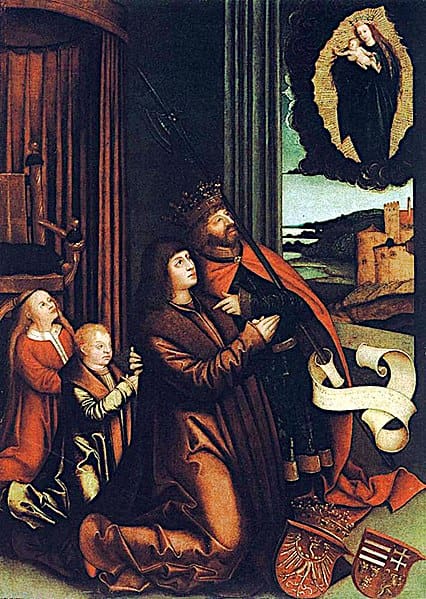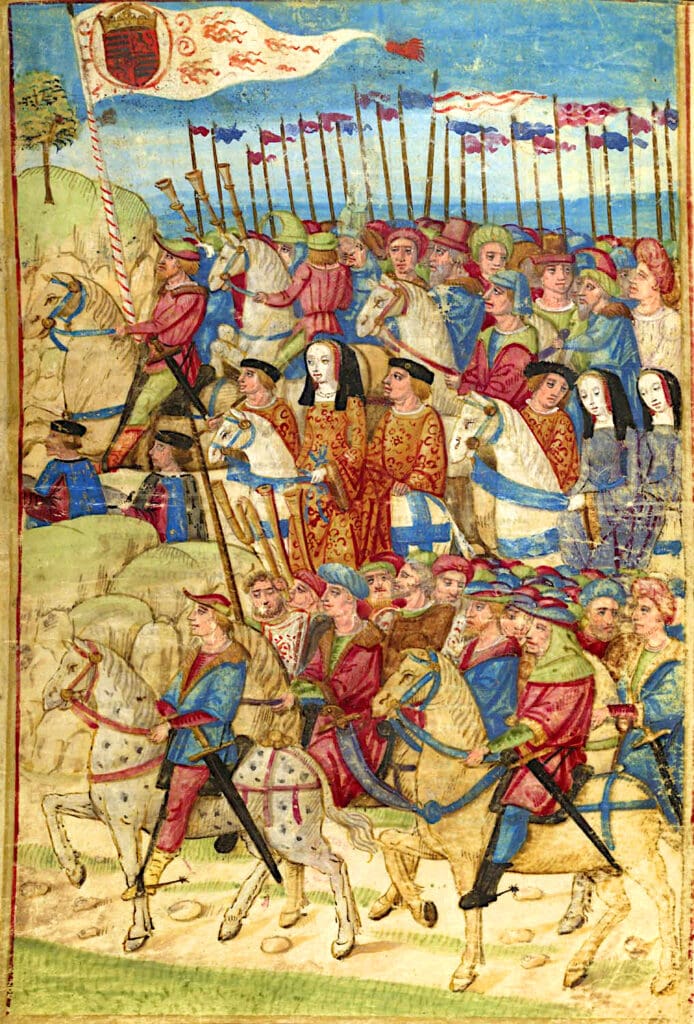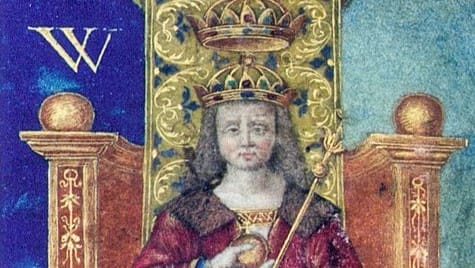Hungarian public opinion traditionally regards the period between the death of Matthias Corvinus in 1490 and the Battle of Mohács in 1526, that is, the reign of Vladislaus II (r. 1490–1516) and his son Louis II (r. 1516–1526), two members of the Jagiellonian Dynasty, and the reign of John Szapolyai (r. 1526–1540), a relative of the Polish kings, as extremely negative. The contrast between the brilliant achievements of King Matthias Corvinus of Hungary (r. 1458–1490) and the inertia of the kingdom of the Jagiellonians is almost a cliché in Hungarian history. To this day, many seek the causes of the 1526 Mohács tragedy in the damaging reign of the weak Jagiellonians. However, more recent Hungarian and international historical research has taken a much more positive view of the Dynasty’s performance, particularly of King Vladislaus II.[1] Not least, the country was made part of the Jagiellonian Empire thanks to them, since the two Jagiellonian kings were also Czech kings at the same time, while their relatives were on the Polish throne.
For the Hungarians, the accession of Vladislaus II to the throne was in fact the beginning of a long-awaited era of peace.
Although it is true that the resources of the Czech–Polish–Hungarian Empire, the largest in Europe, could never be united or effectively used against the Ottomans, it was still during the reign of Vladislaus II that Hungarian humanism, as well as Hungarian art, influenced by the late Gothic and the Italian Renaissance, prospered.
One of the reasons for the negative perception of these kings by posterity is that their reigns are judged not by the famous Italian court chronicler Antonio Bonfini, but by the highly critical George of Sirmium (c.1490–1548). The author was an active royal chaplain at the royal court. His work is tellingly entitled On the Decay of Hungary, which influences the opinions of scholars to this day, and the general reading public took for granted all the gruesome stories he wrote to ruin the reputation of the Hungarian politicians and kings of the time.[2] However, he was not alone: the reign of the Jagiellonians was seen by his contemporaries as a time of moral decay as well, for whose sins God retaliated by allowing Ottoman armies to invade the country and by allowing the medieval Kingdom of Hungary to fall at the Battle of Mohács in 1526.
George’s work has remained at the forefront of modern historical research since its rediscovery in the 19th century, the reason for which can be found in the radical break with traditional forms of historical narrative. With his chronicle, a new genre of Hungarian historiography emerged, which can be called contemporary history, if by that we mean subjective history. The author describes everything that bears witness to a personal experience of the past, of what had happened. Their historical source value lies in the fact that many of their seemingly fantastic stories, rumours, and visions of the future were interpreted by contemporaries as the driving forces behind the Hungarian history of the 16th century, which was not short of unexpected turns and tragedies.

The chronicler ridicules all three kings, especially Vladislaus II, on numerous occasions. A well-known story is that his subjects usually referred to the king only as ‘Dobzse László’ (‘King Very Well’ in English, from Czech ‘dobře’ and Polish ‘dobrze’), because he replied to any request addressed to him that it was ‘very well’. Thanks to this chronicle, we remember Vladislaus II as a feckless, weak-handed monarch, who was widely derided as an ‘ox’ in contemporary Hungary. According to legend, the King was so poor that he was forced to eat simple ‘street food’ in the marketplace along with the commoners. Here, for the first time, we are confronted with an author who consistently considers what is gossiped about on the street to be part of ‘history’. This may be seen as a recognition of the importance of public opinion, but it may also be an insight into the intellectual workshop of a contemporary writer who looked at history from underneath all along.
From the point of view of historical criticism, events do not become credible even if the author notes, as he often does, that he witnessed or heard them personally. In prominent moments of contemporary Hungarian history, such as the coronation of John Szapolyai in Székesfehérvár in 1526, he embeds his reservations about the King in a tale:
‘And they put the angelic crown on his head…And I watched him as he sat in his finery. Suddenly, the angelic crown began to slide on the head of John Szapolyai, and the bishops held it with their hands. But as soon as they let go of it, it slid to one side again. They said he did not deserve it as he had defiled his hands with blood on the crusaders, because he had betrayed them with his faith[3]…And so he was ordained, but the audience told these stories. For, my dear brothers and sisters, the word of the people is the word of God.’
His stories, if not true, show at least a great deal of tone-setting background. A similar rumour is when, for example, King Louis II, before his fateful departure for the Battle of Mohács against the Ottomans, binds the citizens of Buda to bathe his puppies twice a week in his absence.
The agitation of his work and his reproaches against the leaders of the time may be largely rooted in a sense of being out of touch:
if there is no political force capable of leading the country out of the crisis, who can one identify with?
Today’s readers and historians alike have been struck by George’s social sensitivity and the vehemence with which he condemned prodigal, idle, and semi-literate lords and even high priests. From the biblical premise of his work, that ‘[God] will put those wretches to a miserable death and let out the vineyard to other tenants’ (Mt 21:41), it logically follows that human wickedness and moral decay are to be blamed for the loss of the kingdom. Indeed, few in his work end in natural death; knife, poison, and treachery are the fate of the political figures from King Matthias to King Louis II and John Szapolyai, while in reality, none of them was murdered. As he puts it, ‘the Hungarians have three natures: hatred, reproach, and murder…who, though placed in great authority by the Almighty God, have become ungrateful…And so the Almighty God gave the Kingdom of Pannonia to another foreign nation…’. The influence of Franciscan spiritualism and radicalism explains George’s deep sympathy for the peasant warriors who broke out during the reign of Vladislaus II, whom he consistently refers to as ‘crusaders’.
He believed that unbelief in its various forms became the basis for the betrayal of Christianity and the country. It is as if we were sitting in the Ship of Fools, Sebastian Brant’s famous political satire of 1494 in Basel, which was a cultural critique of the time.[4] In it, the world leaders, the Pope, the Emperor, the cardinals, and the princes, care nothing for the decline of faith—and this is exactly what their Hungarian compatriots are like.
At the same time, we must share George’s astonishment and passion for explanation when the medieval Hungarian superpower fell apart before his eyes, and its ecclesiastical and secular leaders became divided against themselves. Indeed, political cataclysm brought out the worst in the politicians of the age, revealing to their contemporaries depths of moral decay they would not have dared to dream of a few decades earlier. It is no coincidence that, as in all times of crisis, the significance of the Hungarian crown and the importance of coronation ceremonies increased in George’s eyes. Throughout, the author speaks simply of the Holy Crown, of the territories belonging to the Holy Crown. He makes it clear that the Holy Crown has become the symbol of the disintegrating Hungarian state and the disappearing unity.
Of course, at the same time,
it is clear that George was unjust, as Hungarian politicians of the time did try to find support for their anti-Ottoman policies in European conditions.
Two of the Jagiellonian rulers, Vladislaus I and Louis II, were left dead fighting the Turks on the battlefield in 1444 and 1526 respectively, and they were also members of the European political elite. Vladislaus II married the French Princess Anne of Foix-Candale; his son Louis II was the husband of Mary of Hungary; while Louis’ sister was married to Ferdinand I, later Holy Roman Emperor.
The country and its capital were an internationally respected royal centre, where foreign envoys often came to persuade the still influential Hungarian king of the advantages of joining certain alliances. Thus, not far from Buda, in the town of Tata, a meeting was organized in connection with a Diet, where seven different European powers were represented by the envoys of the Emperor, the King of France, the Pope, Venice, the King of Poland, and the Voivode of Moldavia and Wallachia. The German and French sides wanted to engage the Hungarian army against Venice, offering the Hungarian King the prospect of regaining Dalmatia, which had been lost in the early 15th century. However, this was seen as risky and opposed by the Hungarians in the shadow of the growing Ottoman threat, as Venice was one of the country’s most important allies against the Ottomans. The Pope thought so too, and after the closing of the conference on Sunday 7 July, during the morning mass, the Papal legate consecrated Vladislaus II as the champion of Christianity. He was presented with the blessed sword and cap sent by the popes to secular rulers, placing on his head a purple velvet hat with a beaded, ermine-embroidered brim, symbolizing the protection of Christians, and in his hand a long sword, a badge of war against infidels. Among others, the Albanian hero of freedom, Gjergj Kastrioti, also known as Skanderbeg, or the Hungarian Kings Sigismund, Vladislaus I, and Matthias I also received one, but only the sword of Vladislaus has survived.

Aware of the Turkish threat, Hungarian politicians tried to maintain Hungary’s room for manoeuvre in foreign policy, which was temporarily successful. The Tata Diet was thus part of the international political system in which the Kingdom of Hungary was still an equal partner. Interestingly, the court chronicler of the time did not consider any of this worth recording—perhaps even the average man of the time did not perceive high politics either, but only saw that the collapse of domestic and foreign policy was approaching day by day.
[1] Martin Rady, ‘Rethinking Jagiello Hungary 1490–1526’, Central Europe, Vol. 3, No. 1, 2005, pp. 3–18.
[2] So far, Hungarian, Serbian, and Slovak translations of the work in Latin have been published in Budapest in 1961 and 1979; in Belgrade in 1987; and in Bratislava in 2023. The only surviving manuscript was in Vienna until 1933, since then it has been kept in Budapest in the National Széchényi Library.
[3] A reference to the great Hungarian peasant uprising of 1514.
[4] Sebastian Brant, Ship of Fools, transl. by Edwin H. Zeydel, New York, 1944.
Related articles:








